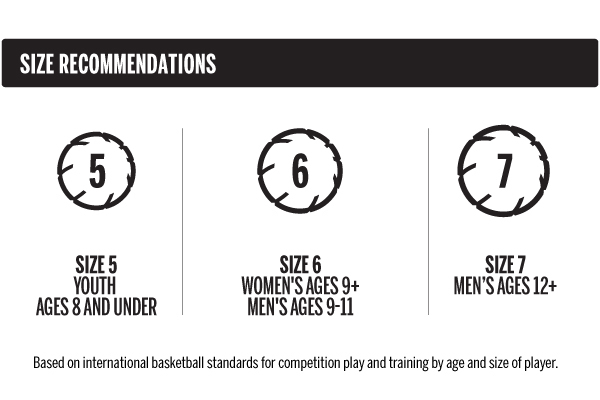The Basics: Basketball
Choosing a Basketball
Picking out a basketball may seem simple. However, there are a few considerations to keep in mind, such as the age of players, skill level and environment. Because children have smaller hands, they play with smaller basketballs.
When choosing the correct basketball, be aware that there are three different materials available. Selecting one is often based on the type of court on which you will be playing.
Outdoor courts have rougher surfaces compared to indoor and can cause the surface of a basketball to wear away faster. If you use the incorrect ball for the court, it can result in awkward bouncing and more wear and tear.
Depending on your skills, age and whether you are playing inside or out, you have three basketball options to choose from to help you train. The three basketball materials are as follows.
- Leather: All professional leagues use authentic leather basketballs. Made from genuine leather, they are soft to the touch and used for indoor courts.
- Rubber: Beginners often use rubber basketballs. They are more durable, bounce well and are ideal for asphalt courts.
- Synthetic: Composite leather feels like genuine leather, but doesn’t need excessive use and time for the material to break in. You can use synthetic leather basketballs for both indoor and outdoor courts, as they offer superior control and grip.

Equipment
What equipment do you need for basketball? While there are dozens of different pieces of equipment and gear that can help prepare you for training and game day, the primary equipment your child will need is as follows.
- Basketball: Please refer to the chart above for the correct sizing
- Athletic shorts: If your daughter or son’s team doesn’t have official uniforms, athletic shorts are vital for training and games. They are loose-fitting, comfy and allow you to move quickly with each step. There are no restrictions on your legs or lower body.
- Athletic socks: Like with any pair of shoes, socks prevent blisters and create additional support and comfort. Trainers sometimes recommend wearing two pairs of athletic socks for even more stability.
- Basketball sneakers: The must-have basketball gear is the basketball shoe. It is vital to help you perform every task within the game, whether you are sprinting, jumping or pivoting on the court. Basketball sneakers provide players with more support in comparison to running shoes and help you maintain high traction while also supporting your ankles.
- Jerseys or athletic shirts: Similar to athletic shorts, a basketball jersey helps you move with ease without restrictions on your upper body and arms. Wearing a loose-fitting fabric, you can pass, jump and run without feeling uncomfortable.
- Slides: Slides are excellent while getting ready for a game in the locker room and afterward when leaving the court. Because the shoes are easy to slide on and off, you can change in and out of your uniform while remaining comfortable.
- Water bottles: As part of your basketball equipment checklist, water bottles are something you can’t forget. Fill them with water, Gatorade, Powerade or other sports drinks to keep your child hydrated.
Picking the right Basketball Shoes
Measure feet: Having a professional from an athletic store measure your feet will help determine the correct size and whether you require a narrow or wide fit.
Determine basketball style: Depending on if you are a fast, all-around player or a power player, different shoes accommodate different positions. If you are an all-around player, choose lightweight sneakers with flexibility that provide support and a moderate level of cushion. Power players will require heavier shoes with excellent stability and cushion.
Choose the level of protection: Purchase low-top basketball shoes that provide fewer restrictions and are lightweight for speed. Designed for aggressive players, high-top sneakers offer maximum support.
Select appropriate soles: All basketball shoe soles are made of rubber with a specific pattern on the bottom to increase your grip and traction. However, some sneakers are designed for indoor training, while others are better for outdoor courts.
Try on shoes: It’s always a smart idea to try on your basketball shoes to make sure they feel snug, but not too tight. You will want a small space between your toes and the end of the shoe. Walk and run around to feel them out, too.
While there are many colors and styles, you shouldn’t worry about brand name or appearance. Focus on performance and comfort, as basketball sneakers will provide expert ankle support to prevent rolled or even sprained ankles.